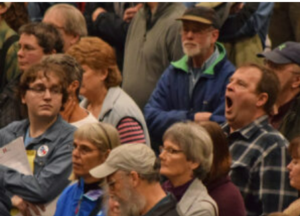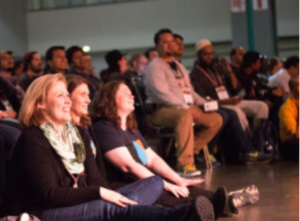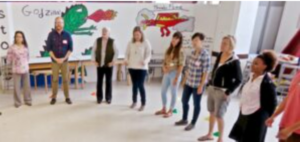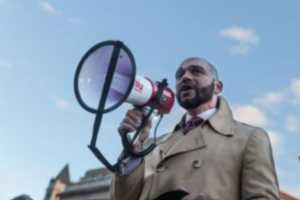The Importance of Knowing your Audience & Speaking Situation

What is a presentation without an audience? Seriously, if you didn’t have an audience, you would be speaking to yourself, or, maybe, your pet. Speeches are meant to be spoken to a person or group. The audience plays a central role in public speaking. In fact, the audience is the reason for giving a speech.
Know your Audience
What is an audience? Technically, it is any one, or group, that is listening to someone convey a message. This conveyance may take many forms but the action is the same – the speaker creates and relays a message out to a receiver(s).

We have all sat through speeches where we didn’t feel a connection to the speaker. The speaker may have outlined what he or she wanted to say without thinking about what the audience wants to hear. The speaker can know what content is important to relay but must also know how the audience wants to hear this information.

Connection is key in public speaking. That spark that one feels when a dynamic speaker presents information is the goal. The audience can feel electrified if the speaker is presenting information that is directly relevant and uses language that resonates with the whole audience. Creating a connection where the speaker bonds with the audience makes the difference between an okay speech and a great speech.
Knowing about the audience and the event allows you to tailor the speech to a particular audience and a particular speaking situation. Consider these two scenarios.
Scenario 1
Janelle, who just completed a summer internship researching PTSD and substance abuse, is invited to present her work to a gathering of physicians. This presentation seems like a perfect opportunity to help medical professionals better understand this complex problem. She puts together a powerful presentation that uses stories from her research to illustrate the vicious circle of trauma and addiction and plans breakout groups in which the physicians would explore how their own work could be improved by a trauma-informed approach to medical care.

When she arrives at the event, she discovers that she is one of four students being featured at the event as the recipients of “Rising Research Stars” scholarships. The event itself, she learns, is a holiday luncheon for a local physicians’ group. Even though the scholarship presentation is only a small part of the event, she is allowed to give her full presentation. The crowd seems engaged at first, but she can tell they are losing focus halfway through.
Afterwards, one of the organizers says, “that’s very impressive work you’re doing. Kind of a downer for a holiday party, though.” He laughs, but Janelle realizes he’s right: she gave the right presentation for the wrong crowd.
In a way, Janelle isn’t the only one at fault here: the organizers didn’t give her enough information to understand her role in the event. The mismatch between her presentation and the audience’s expectations could have been avoided, though, if she had asked a few questions about the nature of the event: What kind of gathering is it? Who will be there? What are they hoping to learn from me?
Scenario 2
Jaden needs to train day care employees on changes in their health and safety procedures. Jaden knows that this topic is critical as the workers have to make sure that all the little ones get the best care. Jaden does his homework and asks the day care manager about the attendees – how many there will be along with some demographic information. Even better, Jaden visits the day care to observe the people who will attend.

This prior knowledge gives Jaden information on how to construct his presentation. He will know the age, gender, and roles of the people attending. He will know how the daycare operates and what the facility looks like. He’ll know the number of people attending. When Jaden creates his training, he will keep this information in mind. He can tailor the language, examples, humor, and experience to the group. When Jaden conducts the training, the audience can tell that this training is just for them.
During the speech, Jaden can gauge the audience’s reaction. He can look for visual cues such as eye contact, body language, questions, and so on. He can tell if he is losing his audience if he sees someone dozing off in the back. He can tell if he is winning the audience by head shakes. Jaden will know from this feedback how engaged the audience is and can adjust his presentation based on what he observes.
Tailoring a speech to one’s audience is the best way to get them to be invested in what you’re saying.
You can view the transcript for “Knowing Your Audience” here (opens in new window).
Here is the video with accurate captions: Knowing Your Audience (opens in new window).
Know your Speaking Situation
Imagine if your boss came to you and said, “Great work on that last project. I’d really like you to present your findings.” What would be the first questions you’d ask? Most likely, you’d want to know more about the speaking situation. What’s the occasion? Where will it take place? Who will be in the audience? How many people will be there?
Occasion
Before preparing your speech, you should know as much as possible about the occasion. Why are you speaking? Are you the only one? Is there a wider significance, such as a celebration, a political event, or a commemoration, or are you the occasion? Since the latter is rarely the case, it’s wise to think about how the occasion or event will figure into your speech.
Location

It’s always a good idea to know where you’re speaking. What is the building or room usually used for? If the speech is outdoors, what kind of space is it? Speakers often call attention to the location they’re speaking in: “In classrooms like this, students hear every day that they should put two spaces after a period. But today I intend to prove to you that a single space is more than enough.”
Audience Size
How many people are expected to attend your speech? Will you be speaking in a large meeting room filled to capacity? A small training room? The way you develop your speech may differ depending on the size of your audience. You may plan for more interaction with smaller groups, and perhaps plan on taking questions as they occur, whereas your strategy might differ with larger groups. Group size also may influence visual aids that you decide to use. For example, with a small audience in a small room, you might hold up a special object that’s the focus of your speech. But in a large room, you’d need to plan on projecting a photograph of the object so everyone can see.
Time
When you think about the time in which you’re speaking, it’s not enough to know the speech is at 9:00 a.m. on a Tuesday; you also have to think about recent or ongoing events in the lives of your audience. An audience in Southern California might have forest fires on their mind or they might be thinking about a Lakers championship win the night before. A recognition of important shared experiences can show your audience you’re present with them. It can sometimes be helpful to look into notable events in history, or whether there are any significant anniversaries around the time of your presentation. For instance, if a speech about the internet were held around March 10, one could say, “Nearly 145 years ago to the day, Alexander Graham Bell made the first telephone call” and then riff on what Bell might say about the internet. Finally, it’s often a good idea to check the major religious calendars for the date of your event. If your speech coincides with a religious day of mourning, for instance, it can sometimes be a welcome gesture to point this out (though do your homework first if the religious observance isn’t known to you already).
